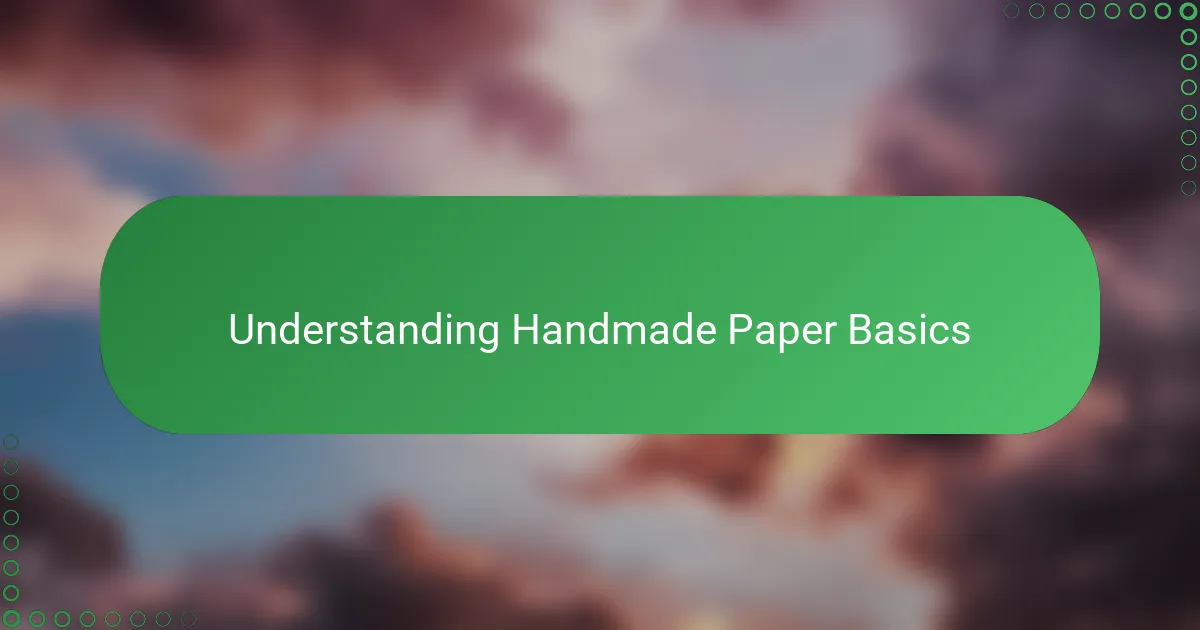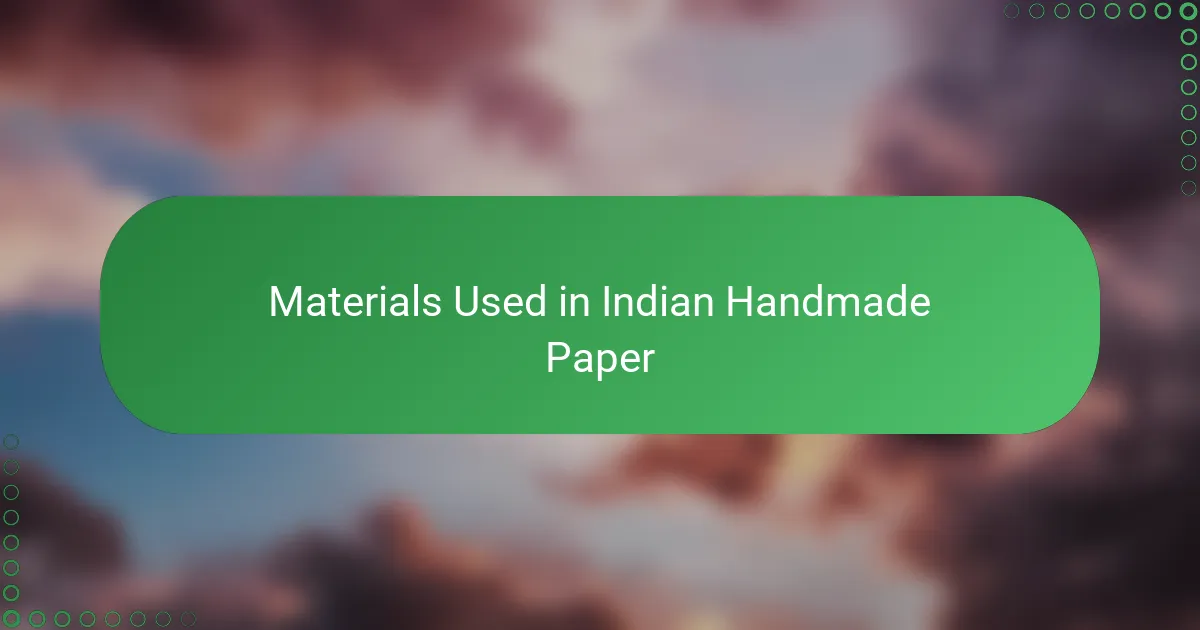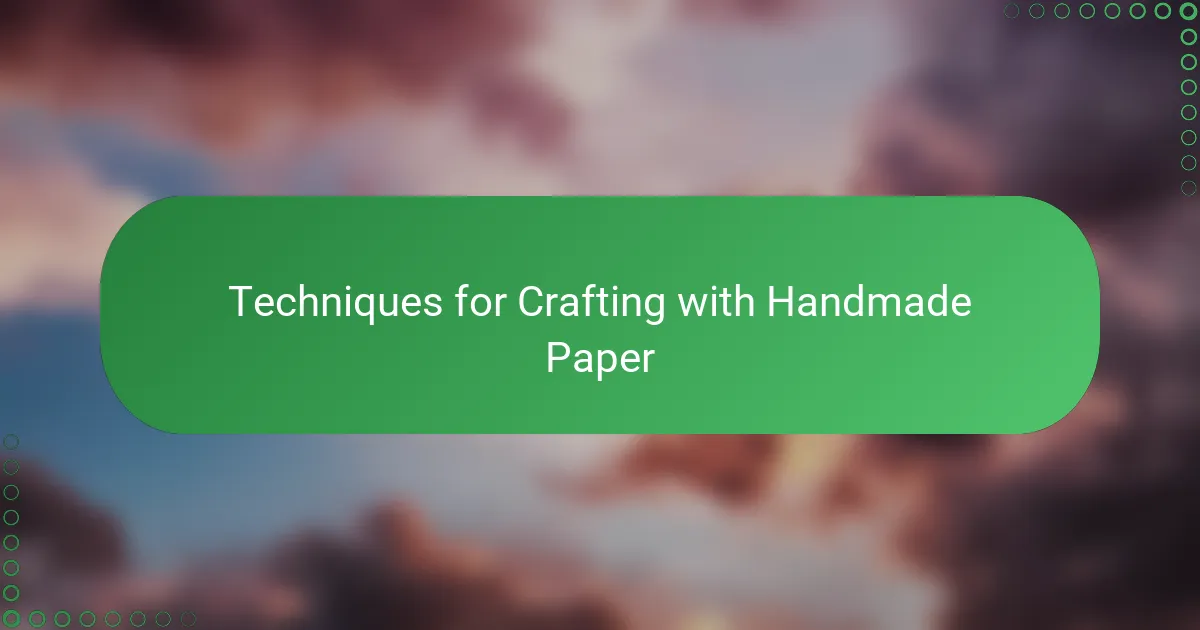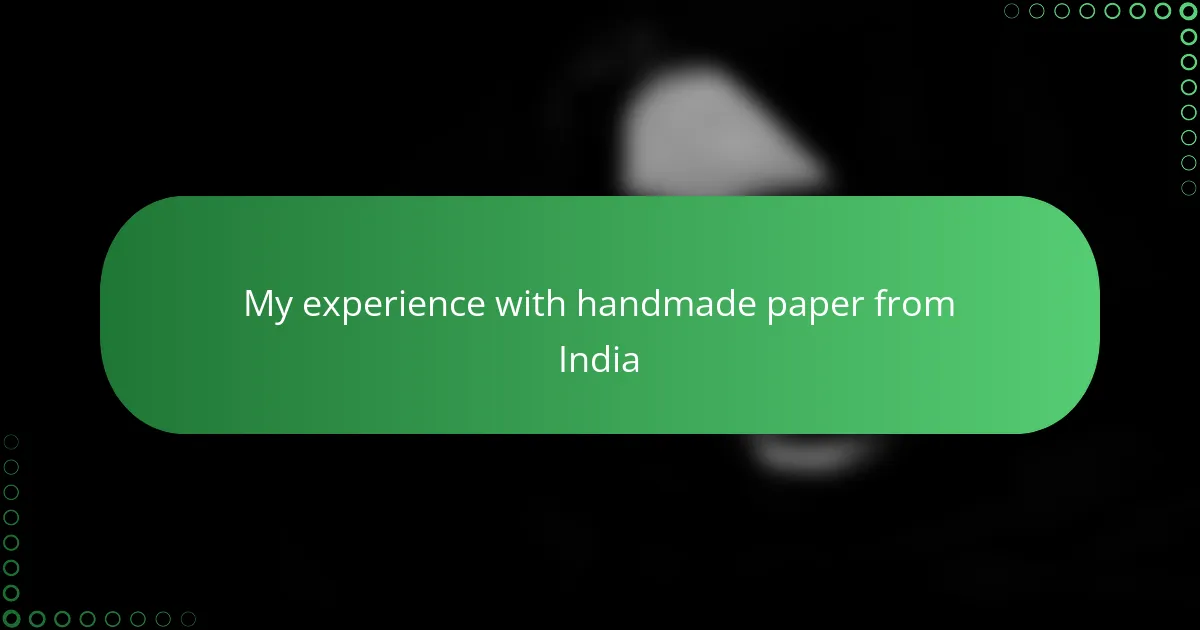Key takeaways
- Handmade paper’s unique texture and character derive from traditional crafting methods and the natural materials used, offering a personal connection to the artisans.
- Artisans often use recycled materials, transforming discarded fibers into beautiful paper, emphasizing sustainability and environmental respect.
- Working with handmade paper requires patience and gentle handling; its imperfections and variations inspire creativity and authenticity in crafting projects.
- Selecting quality handmade paper involves looking beyond surface flaws to appreciate its character, thickness, and how it interacts with light and touch.

Understanding Handmade Paper Basics
When I first encountered handmade paper from India, I was struck by its unique texture and subtle imperfections. Unlike machine-made paper, each sheet tells a story through its uneven fibers and natural variations, reminding me that this craft honors the hands that create it. Have you ever noticed how these small differences make something feel more personal and alive?
Understanding how handmade paper is made helped me appreciate the patience and skill behind each sheet. The artisans use traditional techniques, dipping a frame into a pulp made from recycled fibers, then carefully lifting and drying it in the sun. It’s fascinating to realize that this time-honored process, often unchanged for centuries, brings both durability and character that modern methods can’t replicate.
What truly surprised me was how the choice of raw materials influences the final product’s feel and appearance. For instance, papers crafted from cotton or jute fibers have a completely different softness and strength compared to those made from other plants. This made me realize that handmade paper is much more than just a medium—it’s an expression of nature’s variety and the maker’s intention combined.

Materials Used in Indian Handmade Paper
The materials used in Indian handmade paper truly fascinated me. I learned that artisans often rely on recycled cotton rags, bark fibers, and even leftover textile waste. It’s amazing how something discarded can transform into such a beautiful, tactile sheet of paper, don’t you think?
When I touched a piece made from the bark of the lokta tree, I could immediately feel its unique texture—slightly rough yet surprisingly sturdy. This choice of natural fibers not only adds character but also connects the paper to the environment, reflecting the artisan’s respect for sustainable materials.
What struck me most is how these materials influence every aspect of the paper’s personality, from its weight to how it soaks up ink or paint. I’ve often wondered: can a material so humble really inspire such elegance? Experiencing it firsthand showed me that in handmade paper, the raw fibers are the silent storytellers.

Techniques for Crafting with Handmade Paper
Working with handmade paper from India opened my eyes to the delicate balance between its fragility and resilience during crafting. I learned quickly that tearing or cutting demands a gentle touch, almost like handling an old, treasured letter. Have you ever hesitated before cutting into something that feels alive with history? That careful approach made me appreciate the paper’s unique character even more.
One technique I found particularly rewarding is layering handmade paper to create texture and depth. Gluing multiple sheets together reveals patterns in the fibers that shift with every angle of light, almost like a secret waiting to be uncovered. From my experience, this method transforms simple sheets into rich, tactile surfaces perfect for cards or journal covers.
Working with paints and inks on handmade paper also challenged me to adapt my usual techniques. Because the fibers absorb liquids differently, you need to apply colors more thoughtfully to avoid bleeding or oversaturation. Interestingly, this constraint pushed me to slow down and embrace imperfection, which ultimately added a charming authenticity to my projects. Have you ever found that limitations inspire your creativity rather than stifle it?

Selecting Quality Handmade Paper
Selecting quality handmade paper felt like a treasure hunt during my first experience. I quickly realized that not all sheets are created equal—some were soft and pliable, while others felt coarse or brittle. Have you ever picked up a piece of paper and instantly sensed its potential just by the way it feels in your hands?
I learned to look beyond the surface, paying attention to the paper’s thickness and how evenly the fibers were distributed. One memorable time, I almost overlooked a sheet because of its irregular edges, only to find it incredibly strong and perfect for my project. That moment taught me that quality in handmade paper isn’t about flawlessness, but about character and usability.
Choosing well-made handmade paper also means checking how it reacts to touch and light. When I held a translucent sheet up, seeing how sunlight danced through its fibers, I felt connected to the artisan’s meticulous work. Isn’t it fascinating how this paper carries the imprint of nature and craftsmanship right into your hands?

My Personal Crafting Experience
Working with handmade paper from India quickly became more than just a crafting task for me—it turned into a deeply personal journey. I remember the first time I felt the rough, fibrous texture beneath my fingertips; it was almost as if the paper was whispering stories of the artisans who lovingly crafted it. Have you ever had a material that seemed to breathe life into your work simply by being in your hands?
One project stands out in my memory where I tried creating a handcrafted journal cover. The delicate balancing act between applying enough pressure and preserving the paper’s fragile beauty taught me patience like never before. At times, I worried I might damage the sheet, but that very cautiousness made the process feel intimate and rewarding, a reminder that crafting with handmade paper calls for respect and mindfulness.
I also discovered that the natural inconsistencies in each sheet sparked my creativity more than I expected. Rather than striving for perfection, I embraced the uneven edges and slight color variations, letting them guide my designs. Isn’t it amazing how imperfections can turn into your best creative assets when you’re working with something so uniquely alive?

Creative Projects with Handmade Paper
When I started experimenting with handmade paper, I was amazed by how it transformed simple ideas into textured masterpieces. For instance, creating greeting cards using layered sheets added a tactile dimension that felt genuinely heartfelt—each fold and fiber seemed to carry a story.
One of my favorite projects was making paper flowers, where the unique fibers gave each petal a soft, organic look that no store-bought paper could match. Have you ever noticed how handmade paper invites you to slow down and savor every cut and crease? That mindfulness really deepened my connection to the craft.
Painting on handmade paper also brought unexpected surprises. The way the pigments settled unevenly sparked new ideas and encouraged me to embrace imperfection as part of the beauty. I found that these ‘happy accidents’ often led to the most striking results, turning my projects into memorable art pieces rather than just craftwork.

Tips for Working with Handmade Paper
One thing I quickly learned is to handle handmade paper with gentle care. Unlike standard paper, a rough edge or a sharp fold can easily damage the fibers and change the whole look of your project. Have you ever accidentally torn a precious sheet and felt that little pang of regret? Being patient and tender really makes all the difference.
Another tip I found invaluable is to test adhesives and paints on a small scrap first. Because handmade paper absorbs liquids differently depending on its fiber mix, experimenting helps avoid unwanted bleeding or warping. It reminded me of how trial and error in crafting isn’t a setback but a vital part of discovering the paper’s true personality.
Lastly, embracing the paper’s natural irregularities transformed my approach entirely. Instead of forcing perfection, I learned to design around uneven edges or color variations. This shift not only reduced frustration but also made my creations feel more authentic and alive—just like the handmade sheets themselves. Have you noticed how imperfection often opens the door to unique creativity?
